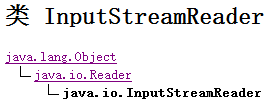1.1 - OutputStreamWriter类
OutputStreamWriter 是字符流通向字节流的桥梁:可使用指定的字符编码表,将要写入流中的字符编码成字节。
它的作用的就是,将字符串按照指定的编码表转成字节,在使用字节流将这些字节写出去。

- 代码演示:
public static void writeCN() throws Exception { //创建与文件关联的字节输出流对象 FileOutputStream fos = new FileOutputStream("c:\cn8.txt"); //创建可以把字符转成字节的转换流对象,并指定编码 OutputStreamWriter osw = new OutputStreamWriter(fos,"utf-8"); //调用转换流,把文字写出去,其实是写到转换流的缓冲区中 osw.write("你好");//写入缓冲区。 osw.close(); }
转换流的构造函数

1.2 - InputStreamReader类
查阅InputStreamReader的API介绍,InputStreamReader 是字节流通向字符流的桥梁:它使用指定的字符编码表读取字节并将其解码为字符。
它使用的字符集可以由名称指定或显式给定,或者可以接受平台默认的字符集。

代码演示:
public class InputStreamReaderDemo { public static void main(String[] args) throws IOException { //演示字节转字符流的转换流 readCN(); } public static void readCN() throws IOException{ //创建读取文件的字节流对象 InputStream in = new FileInputStream("c:\cn8.txt"); //创建转换流对象 //InputStreamReader isr = new InputStreamReader(in);这样创建对象,会用本地默认码表读取,将会发生错误解码的错误 InputStreamReader isr = new InputStreamReader(in,"utf-8"); //使用转换流去读字节流中的字节 int ch = 0; while((ch = isr.read())!=-1){ System.out.println((char)ch); } //关闭流 isr.close(); } }
1.3 - 转换流和子类区别
发现有如下继承关系:
OutputStreamWriter:
|--FileWriter:
InputStreamReader:
|--FileReader;
父类和子类的功能有什么区别呢?
OutputStreamWriter和InputStreamReader是字符和字节的桥梁:也可以称之为字符转换流。字符转换流原理:字节流+编码表。
FileWriter和FileReader:作为子类,仅作为操作字符文件的便捷类存在。当操作的字符文件,使用的是默认编码表时可以不用父类,而直接用子类就完成操作了,简化了代码。
InputStreamReader isr = new InputStreamReader(new FileInputStream("a.txt"));//默认字符集。
InputStreamReader isr = new InputStreamReader(new FileInputStream("a.txt"),"GBK");//指定GBK字符集。
FileReader fr = new FileReader("a.txt");
这三句代码的功能是一样的,其中第三句最为便捷。
注意:一旦要指定其他编码时,绝对不能用子类,必须使用字符转换流。什么时候用子类呢?
条件:
1、操作的是文件。2、使用默认编码。
总结:
字节--->字符 : 看不懂的--->看的懂的。 需要读。输入流。 InputStreamReader
字符--->字节 : 看的懂的--->看不懂的。 需要写。输出流。 OutputStreamWriter